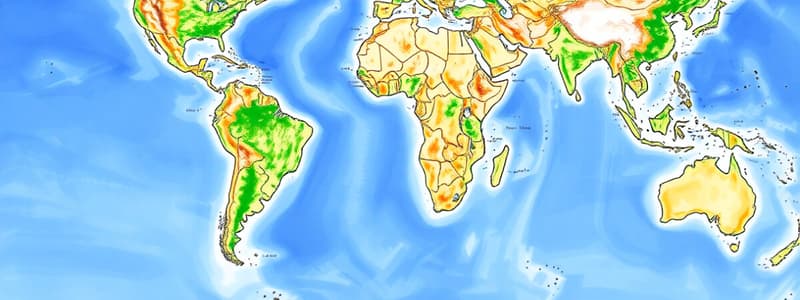Podcast
Questions and Answers
What does physical geography primarily focus on?
What does physical geography primarily focus on?
- Economic systems and urban centers
- Mapping and spatial analysis
- Human activities and cultures
- Natural landscapes and processes (correct)
Which of the following subfields is part of human geography?
Which of the following subfields is part of human geography?
- Cultural geography (correct)
- Geomorphology
- Climatology
- Biogeography
What is a key purpose of Geographic Information Systems (GIS)?
What is a key purpose of Geographic Information Systems (GIS)?
- To map and analyze spatial data (correct)
- To study climate patterns
- To create art based on landscapes
- To document historical events
How is 'location' defined in geography?
How is 'location' defined in geography?
Which concept describes areas defined by common characteristics?
Which concept describes areas defined by common characteristics?
What term describes the growth of cities and the movement from rural to urban areas?
What term describes the growth of cities and the movement from rural to urban areas?
Which tool is primarily used for navigation and determining location?
Which tool is primarily used for navigation and determining location?
What does the term 'sustainability' emphasize in geography?
What does the term 'sustainability' emphasize in geography?
Flashcards are hidden until you start studying
Study Notes
Definition
- Geography: The study of the Earth’s physical features, environments, and human interactions.
Branches of Geography
-
Physical Geography:
- Focuses on natural landscapes and processes (e.g., mountains, rivers, climate).
- Subfields include climatology, geomorphology, and biogeography.
-
Human Geography:
- Examines human activities, cultures, and their relationships with the environment.
- Subfields include urban geography, economic geography, and cultural geography.
-
Geographic Information Systems (GIS):
- Tools used for mapping and analyzing spatial data.
- Applications in urban planning, environmental management, and disaster response.
Key Concepts
-
Location: Refers to the specific position of a place on the Earth’s surface (absolute vs. relative).
-
Place: Describes the physical and human characteristics that define a location (landforms, cultures).
-
Region: Areas defined by common characteristics (cultural, physical, or political).
-
Movement: Refers to the mobility of people, goods, and ideas across the planet.
-
Human Environment Interaction: Examines how humans adapt to and modify their environment.
Tools and Methods
-
Maps: Essential for representing spatial information; includes physical and political maps.
-
Satellite Imagery: Provides real-time data for monitoring environmental changes and urban development.
-
GPS (Global Positioning System): Used for navigation and location services.
Important Themes
-
Globalization: The increasing interconnectedness of economies, cultures, and populations.
-
Sustainability: Focus on sustainable practices to manage resources without degrading the environment.
-
Urbanization: The growth of cities and the movement of people from rural to urban areas.
Major Geographical Concepts
-
Continental Drift: Theory explaining the movement of Earth's continents over geological time.
-
Plate Tectonics: Describes the large-scale processes affecting the Earth's crust.
-
Climate Change: The long-term alteration of temperature and typical weather patterns in a place.
Case Studies
-
River Systems (e.g., Amazon, Nile): Study of ecosystems, human settlements, and agriculture.
-
Urban Centers (e.g., New York, Tokyo): Analysis of urban geography, economic systems, and cultural dynamics.
Importance of Geography
- Aids in understanding global issues like climate change, resource management, and development strategies.
- Provides critical insight for planning, environmental conservation, and disaster management.
Geography Definition
- Geography examines Earth's physical features, environments, and human interactions.
Branches of Geography
- Physical Geography focuses on natural landscapes and processes.
- Examples include mountains, rivers, climate, etc.
- Subfields include climatology, geomorphology, and biogeography.
- Human Geography focuses on human activities, cultures, and their relationship with the environment.
- Subfields include urban geography, economic geography, and cultural geography.
- Geographic Information Systems (GIS) are tools for mapping and analyzing spatial data.
- Applications include urban planning, environmental management, and disaster response.
Key Concepts in Geography
- Location refers to a place's position on Earth's surface.
- Absolute location uses coordinates, while relative location describes position relative to other places.
- Place highlights the unique characteristics of a location.
- These can be physical (landforms) or human (cultures).
- Region is defined by common characteristics (culture, physical, or political).
- Movement refers to the mobility of people, goods, and ideas across the planet.
- Human-environment interaction examines how humans adapt to and modify their environment.
Tools and Methods in Geography
- Maps are essential for representing spatial information and include physical and political maps.
- Satellite imagery provides real-time data for monitoring environmental changes and urban development.
- GPS (Global Positioning System) is used for navigation and location services.
Important Themes in Geography
- Globalization refers to the interconnectedness of economies, cultures, and populations.
- Sustainability focuses on managing resources without degrading the environment.
- Urbanization refers to the growth of cities and the movement of people from rural to urban areas.
Major Geographical Concepts
- Continental Drift explains the movement of Earth's continents over geological time.
- Plate Tectonics describes the large-scale processes affecting Earth's crust.
- Climate Change refers to the long-term alteration of temperature and typical weather patterns in a place.
Case Studies
- River Systems (e.g., Amazon, Nile) help study ecosystems, human settlements, and agriculture.
- Urban Centers (e.g., New York, Tokyo) are used to analyze urban geography, economic systems, and cultural dynamics.
Importance of Geography
- Geography helps understand global issues like climate change, resource management, and development strategies.
- It provides insight for planning, environmental conservation, and disaster management.
Studying That Suits You
Use AI to generate personalized quizzes and flashcards to suit your learning preferences.




